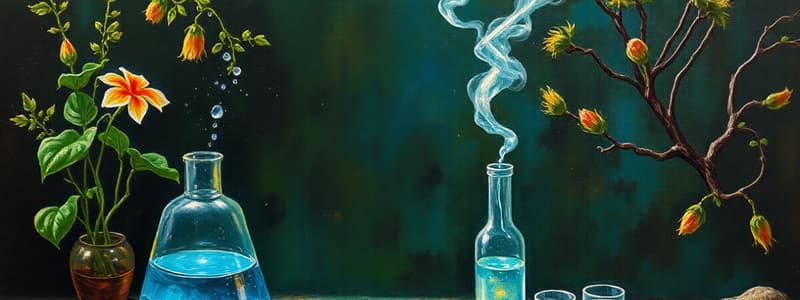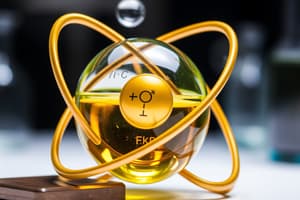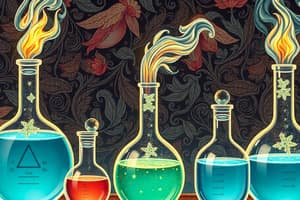Podcast
Questions and Answers
What characterizes an anion in a chemical reaction?
What characterizes an anion in a chemical reaction?
- It can only form covalent bonds.
- It loses electrons to achieve a stable electron shell.
- It is always positively charged.
- It gains electrons from other atoms. (correct)
Which statement best describes cations?
Which statement best describes cations?
- They are formed through covalent bonding.
- They have a positive charge due to electron loss. (correct)
- They are always formed from non-metals.
- They can never bond with anions.
What is the primary driving force behind the formation of an ionic bond?
What is the primary driving force behind the formation of an ionic bond?
- The electrostatic attraction between opposite ions. (correct)
- The equal sharing of electrons in covalent compounds.
- The sharing of electrons between non-metals.
- The attraction between two positive ions.
Which compound is an example of a covalent bond?
Which compound is an example of a covalent bond?
What occurs during the formation of NaCl?
What occurs during the formation of NaCl?
How does a covalent bond differ from an ionic bond?
How does a covalent bond differ from an ionic bond?
Which element would most likely form a cation?
Which element would most likely form a cation?
What is a characteristic of ionic compounds?
What is a characteristic of ionic compounds?
What is the primary characteristic that differentiates a chemical change from a physical change?
What is the primary characteristic that differentiates a chemical change from a physical change?
Which products are typically formed during combustion?
Which products are typically formed during combustion?
Which of the following conditions is NOT necessary for corrosion to occur?
Which of the following conditions is NOT necessary for corrosion to occur?
What is a common method to prevent corrosion on metals?
What is a common method to prevent corrosion on metals?
What is the effect of abiotic factors on ecosystems?
What is the effect of abiotic factors on ecosystems?
What occurs during precipitation reactions?
What occurs during precipitation reactions?
Which statement accurately describes the role of zinc in galvanizing metal?
Which statement accurately describes the role of zinc in galvanizing metal?
What is the result of hydrogen gaining one electron during the formation of water?
What is the result of hydrogen gaining one electron during the formation of water?
What role does light play in a forest ecosystem?
What role does light play in a forest ecosystem?
Which process in the nitrogen cycle directly involves plants?
Which process in the nitrogen cycle directly involves plants?
Which statement best describes the carbon cycle in ecosystems?
Which statement best describes the carbon cycle in ecosystems?
What is the primary function of decomposers in the nitrogen cycle?
What is the primary function of decomposers in the nitrogen cycle?
What is the significance of wind in a forest ecosystem?
What is the significance of wind in a forest ecosystem?
How is nitrogen returned to the atmosphere in the nitrogen cycle?
How is nitrogen returned to the atmosphere in the nitrogen cycle?
Which of the following accurately describes the role of water in a forest ecosystem?
Which of the following accurately describes the role of water in a forest ecosystem?
What happens to carbon when animals die in the carbon cycle on land?
What happens to carbon when animals die in the carbon cycle on land?
Which of the following organs is involved in the gustatory sensory system?
Which of the following organs is involved in the gustatory sensory system?
What is the role of the autonomic nervous system?
What is the role of the autonomic nervous system?
Which component of the nervous system is associated with voluntary control of body movements?
Which component of the nervous system is associated with voluntary control of body movements?
Which sensory system is primarily responsible for detecting light?
Which sensory system is primarily responsible for detecting light?
What type of neurons are involved in sending information from the body to the brain in the somatic nervous system?
What type of neurons are involved in sending information from the body to the brain in the somatic nervous system?
What is the primary reason for the decrease in total mass of organisms at each trophic level?
What is the primary reason for the decrease in total mass of organisms at each trophic level?
Which ecological relationship is characterized by both organisms benefiting from their interaction?
Which ecological relationship is characterized by both organisms benefiting from their interaction?
What happens to the carbon when limestone is exposed to air?
What happens to the carbon when limestone is exposed to air?
Which of the following best describes biomass?
Which of the following best describes biomass?
In what type of relationship do two organisms compete for the same resource?
In what type of relationship do two organisms compete for the same resource?
What is a primary effect of limiting resources on a population?
What is a primary effect of limiting resources on a population?
Which type of relationship involves one organism living inside another, benefiting at the host's expense?
Which type of relationship involves one organism living inside another, benefiting at the host's expense?
What factor affects a population's ability to cope with disease impacts?
What factor affects a population's ability to cope with disease impacts?
What is the primary function of the thyroid gland?
What is the primary function of the thyroid gland?
Which hormone is produced by the adrenal gland to increase alertness during stressful situations?
Which hormone is produced by the adrenal gland to increase alertness during stressful situations?
What process is involved in maintaining homeostasis regarding body temperature?
What process is involved in maintaining homeostasis regarding body temperature?
Which hormone produced by the pancreas plays a crucial role in regulating blood sugar levels?
Which hormone produced by the pancreas plays a crucial role in regulating blood sugar levels?
What effect does aldosterone have on the body?
What effect does aldosterone have on the body?
Flashcards
Ionic Compound
Ionic Compound
A compound formed by the electrostatic attraction between positively charged cations and negatively charged anions.
Cation
Cation
A positively charged ion formed when an atom loses electrons.
Anion
Anion
A negatively charged ion formed when an atom gains electrons.
Ionic Bond
Ionic Bond
Signup and view all the flashcards
Covalent Bond
Covalent Bond
Signup and view all the flashcards
Chemical Reaction
Chemical Reaction
Signup and view all the flashcards
Balancing Chemical Equations
Balancing Chemical Equations
Signup and view all the flashcards
Natural Disaster Ecosystem Effect
Natural Disaster Ecosystem Effect
Signup and view all the flashcards
Chemical World Station Rotation
Chemical World Station Rotation
Signup and view all the flashcards
Physical Change
Physical Change
Signup and view all the flashcards
Chemical Change
Chemical Change
Signup and view all the flashcards
Combustion
Combustion
Signup and view all the flashcards
Corrosion
Corrosion
Signup and view all the flashcards
Corrosion Prevention (Barrier)
Corrosion Prevention (Barrier)
Signup and view all the flashcards
Corrosion Prevention (Sacrificial)
Corrosion Prevention (Sacrificial)
Signup and view all the flashcards
Galvanizing
Galvanizing
Signup and view all the flashcards
Precipitation Reaction
Precipitation Reaction
Signup and view all the flashcards
Ecosystem
Ecosystem
Signup and view all the flashcards
Abiotic Factors
Abiotic Factors
Signup and view all the flashcards
Abiotic Factors
Abiotic Factors
Signup and view all the flashcards
Light's effect on ecosystem
Light's effect on ecosystem
Signup and view all the flashcards
Temperature's effect on ecosystem
Temperature's effect on ecosystem
Signup and view all the flashcards
Wind's effect on ecosystem
Wind's effect on ecosystem
Signup and view all the flashcards
Water's effect on ecosystem
Water's effect on ecosystem
Signup and view all the flashcards
Biogeochemical Cycles
Biogeochemical Cycles
Signup and view all the flashcards
Nitrogen Fixation
Nitrogen Fixation
Signup and view all the flashcards
Nitrification
Nitrification
Signup and view all the flashcards
Assimilation (plants)
Assimilation (plants)
Signup and view all the flashcards
Ammonification
Ammonification
Signup and view all the flashcards
Denitrification
Denitrification
Signup and view all the flashcards
Carbon Cycle (land)
Carbon Cycle (land)
Signup and view all the flashcards
Carbon Cycle (water)
Carbon Cycle (water)
Signup and view all the flashcards
Visual System
Visual System
Signup and view all the flashcards
Auditory System
Auditory System
Signup and view all the flashcards
Touch System
Touch System
Signup and view all the flashcards
Olfactory System
Olfactory System
Signup and view all the flashcards
Gustatory System
Gustatory System
Signup and view all the flashcards
Nervous System (Overall)
Nervous System (Overall)
Signup and view all the flashcards
Central Nervous System (CNS)
Central Nervous System (CNS)
Signup and view all the flashcards
Peripheral Nervous System (PNS)
Peripheral Nervous System (PNS)
Signup and view all the flashcards
Somatic Nervous System
Somatic Nervous System
Signup and view all the flashcards
Autonomic Nervous System
Autonomic Nervous System
Signup and view all the flashcards
Calcium Homeostasis
Calcium Homeostasis
Signup and view all the flashcards
Thyroid Gland
Thyroid Gland
Signup and view all the flashcards
Thymus
Thymus
Signup and view all the flashcards
Adrenal Gland
Adrenal Gland
Signup and view all the flashcards
Cortisol
Cortisol
Signup and view all the flashcards
Adrenaline
Adrenaline
Signup and view all the flashcards
Aldosterone
Aldosterone
Signup and view all the flashcards
Pancreas
Pancreas
Signup and view all the flashcards
Insulin
Insulin
Signup and view all the flashcards
Glucagon
Glucagon
Signup and view all the flashcards
Homeostasis
Homeostasis
Signup and view all the flashcards
Blood pH
Blood pH
Signup and view all the flashcards
Body Temperature
Body Temperature
Signup and view all the flashcards
Vasodilation
Vasodilation
Signup and view all the flashcards
Vasoconstriction
Vasoconstriction
Signup and view all the flashcards
Limestone Formation
Limestone Formation
Signup and view all the flashcards
Carbon Release from Limestone
Carbon Release from Limestone
Signup and view all the flashcards
Energy Flow
Energy Flow
Signup and view all the flashcards
Biotic Factors
Biotic Factors
Signup and view all the flashcards
Biomass Pyramid
Biomass Pyramid
Signup and view all the flashcards
Producers (Autotrophs)
Producers (Autotrophs)
Signup and view all the flashcards
Heterotrophs (Consumers)
Heterotrophs (Consumers)
Signup and view all the flashcards
Biomass
Biomass
Signup and view all the flashcards
10% Energy Transfer
10% Energy Transfer
Signup and view all the flashcards
Mutualism
Mutualism
Signup and view all the flashcards
Commensalism
Commensalism
Signup and view all the flashcards
Symbiosis
Symbiosis
Signup and view all the flashcards
Competition
Competition
Signup and view all the flashcards
Predator-Prey
Predator-Prey
Signup and view all the flashcards
Parasitism
Parasitism
Signup and view all the flashcards
Limiting Resources
Limiting Resources
Signup and view all the flashcards
Seasonal Changes
Seasonal Changes
Signup and view all the flashcards
Diseases
Diseases
Signup and view all the flashcards
Study Notes
Chemical World Notes
- 15 stations are set up around the room for practical exercises.
- Each station will have a practical setup previously done in class. For example: iron rusting in a bottle of HCl.
- There is a 1.5 hour rotation time.
- Students need to answer 2 short questions at each station describing what happened in the practical.
- Part A is worth 30 marks and involves explaining the reactions.
- Part B is 10 marks and relates to chemical world skills and content.
- Part C is 10 marks and relates to the Living World.
- There's a question on graphs in either Part B or Part C.
- Students are not expected to memorize chemical equations like combustion.
- Students need to know how to write simple balanced chemical equations (2 lines).
- No ATSI environment damage.
- Ionic compounds are formed when metal or non-metal loses or gains electrons (e.g. salt).
- Natural disasters can change ecosystems and effect producers.
- No specific labelling of brain parts is required, but understanding the functions of neurons is necessary.
- Neurotransmitters such as dopamine release neurosignals.
- A periodic table is provided.
Molecular Bonding
- Anions are negatively charged atoms that have gained electrons.
- Cations are positively charged atoms that have lost electrons.
- Ionic bonding occurs when oppositely charged ions are attracted to each other.
- Salt (NaCl) is an example of an ionic compound where sodium (Na) loses an electron and chlorine (Cl) gains one.
- This is to achieve full outer shells. After the reaction, sodium becomes a cation and chlorine becomes an anion, forming an ionic bond.
- Covalent bonds form when atoms share electrons.
- Covalent bonds only happen between two non-metals (example: H2O or CO2).
Physical & Chemical Changes
- A physical change alters the state of a substance without changing its chemical composition. Example: water boiling.
- A chemical change transforms a substance into a new substance with a different chemical composition.
- Example of chemical changes: Combustion (fuel and oxygen react to form heat and new products such as CO2 and H2O). Observations include presence of oxygen in reactants, products having water and carbon dioxide, change in temperature
- Corrosion (metals react with oxygen and water to form metal oxides). Requirements include oxygen in the air, and water.
The Living World Notes
- An ecosystem is a community of organisms with its non-living environment (e.g., forests, grasslands).
- Abiotic factors are non-living factors like sunlight, temperature, precipitation, and salinity, which can affect the ecosystem and the types of organisms present.
- For example, forest ecosystems have abiotic factors like light, temperature, wind, and water influencing factors such as photosynthesis, plant growth, seed dispersal, and pollination, among other biota.
- Biogeochemical cycles (e.g., nitrogen, carbon) involve the continuous circulation of elements through various components of the Earth's spheres, demonstrating interactions between living and non-living elements.
Nitrogen Cycle
- Nitrogen-fixing microbes convert atmospheric nitrogen into ammonia.
- Nitrifying bacteria further transform ammonia into nitrites and then nitrates.
- Plants absorb nitrates as essential nutrients.
- Animals consume plants.
- Decomposers break down dead matter, returning nitrogen to the soil in the form of ammonia.
- Denitrifying bacteria return nitrogen to the atmosphere in the form of nitrogen gas.
Carbon Cycle (Land)
- Carbon enters the atmosphere as CO2 through industrial processes (e.g., fossil fuel burning) and respiration (animals and plants).
- Plants remove CO2 from the atmosphere during photosynthesis and use it for energy.
- Animals consume plants, absorbing carbon.
- Decomposition releases carbon back into the atmosphere.
Carbon Cycle (Water)
- Carbon in the form of CO2 is absorbed by water.
- Marine animals use carbon to form shells.
- When organisms die, their shells form limestone deposits.
- Limestone releases carbon back into the atmosphere as CO2 when exposed to air.
Energy Flow
- Biotic factors are living organisms.
- Biomass pyramids show energy flow in ecosystems via producers (autotrophs) and heterotrophic consumers.
- Ten percent of energy is transferred to the next trophic level, while the remainder is lost as heat.
Ecological Relationships
- Mutualism: both organisms benefit.
- Commensalism: one benefits; the other isn't affected.
- Symbiosis: both organisms are interdependent, meaning neither can easily survive alone.
- Competition: both are negatively affected as they compete for resources.
- Predator-Prey: the predator consumes the prey.
- Parasitism: one benefits while the other is harmed.
Natural Disasters and Human Impacts
- Droughts decrease water availability, increasing competition among organisms.
- Floods, earthquakes impact population sizes by killing individuals or decreasing resources.
- Human competition for resources in habitats can lead to significant changes in animal migration and plant removal.
- Pollution can introduce harmful chemicals causing mutations or ecosystem collapse.
Sensory Organs and Nervous System
- Sensory organs receive external and internal stimuli.
- Sensory neurons transmit signal to the CNS and the CNS transmits impulses to motor neurons.
- Motor neurons carry signals to effectors, like muscles, which respond to the signals.
- Reflex arcs are involuntary responses where the spinal cord directly triggers a response to a stimulus. Reflexes happen very quickly without the brain's intervention.
- The brain is composed of billions of specialized neurons that transmit electrical and chemical signals.
- Neurons are the fundamental units of the nervous system, consisting of a cell body, dendrites (receive signals), axon (transmits signals), and terminal buttons (pass signals to other neurons).
- Myelin is a fatty covering around the axon that speeds up signal transmission.
- The nervous system includes: the central nervous system (CNS), containing the brain and spinal cord, and the peripheral nervous system (PNS), encompassing nerves throughout the body communicating with CNS. The PNS is divided into: Somatic Nervous System (voluntary movements) and Autonomic Nervous System (involuntary functions), with sympathetic (alert) and parasympathetic (relaxation) divisions.
Endocrine System
- Hormones are chemical messengers secreted by glands throughout the body.
- Hormones trigger responses in specific parts of the body.
- Various glands such as the pineal, hypothalamus, pituitary, parathyroid, thyroid, thymus, adrenal, pancreas, kidneys, testes, and ovaries produce vital hormones that control many bodily functions, including metabolism, water balance, reproduction, stress response, and blood sugar regulation.
- Examples of specific hormones and their functions, such as cortisol (stress), adrenaline (fight-or-flight), insulin (blood sugar regulation).
Homeostasis
- Homeostasis is maintaining stable internal conditions within the body.
- Key factors involve regulation of blood pH, glucose levels, temperature, and other vital nutrients, all regulated through the release of various hormones.
- Vasodilation (widening blood vessels) and vasoconstriction (narrowing blood vessels) control body temperature, allowing heat to be lost or retained as needed.
Models
- Scientific theories may be too complex for simple understanding.
- Models can simplify theories to make them easier to grasp.
- Models are useful tools to represent complex concepts and to communicate scientific ideas effectively.
- Models have strengths and limitations: models cannot include all the details of complex scientific concepts or theories, models are approximations of real-world phenomena.
Studying That Suits You
Use AI to generate personalized quizzes and flashcards to suit your learning preferences.




